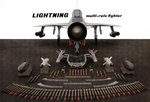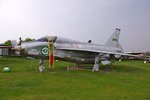Navigation
Install the app
How to install the app on iOS
Follow along with the video below to see how to install our site as a web app on your home screen.
Note: This feature may not be available in some browsers.
More options
You are using an out of date browser. It may not display this or other websites correctly.
You should upgrade or use an alternative browser.
You should upgrade or use an alternative browser.
A study in grace and beauty....there's only one jet worthy the name Lightning....
Ad: This forum contains affiliate links to products on Amazon and eBay. More information in Terms and rules
More options
Who Replied?michaelmaltby
Colonel
Attachments
GrauGeist
Generalfeldmarschall zur Luftschiff Abteilung
I thought it a funny coincidence last night, that while watching an episode of "Voyage To The Bottom Of The Sea": Voyage to the Bottom of the Sea; The Sky Is Falling (TV Episode 1964 - IMDb), that a flight of EE Lightnings were seen attacking the UFO along with B-52 bombers.
The only problem with that, is that the UFO was underwater, off the coast of Southern California!
The only problem with that, is that the UFO was underwater, off the coast of Southern California!
I thought it a funny coincidence last night, that while watching an episode of "Voyage To The Bottom Of The Sea": Voyage to the Bottom of the Sea; The Sky Is Falling (TV Episode 1964 - IMDb), that a flight of EE Lightnings were seen attacking the UFO along with B-52 bombers.
The only problem with that, is that the UFO was underwater, off the coast of Southern California!
EE Lightning could do everything !
GrauGeist
Generalfeldmarschall zur Luftschiff Abteilung
Snautzer01
Marshal
- 46,292
- Mar 26, 2007
To be fair, you could line them up on a runway and both open the throttles, the EE Lightning would get to the other end first !
The P-38 would then over take it and take off as the EE Lightning would have ran out of fuel !
it could not have taken of where a real Lightning would have take off..... Ever...
I may be wrong, but didn't you guys name the P-38 also?
I may be wrong, but didn't you guys name the P-38 also?
Surely not
it could not have taken of where a real Lightning would have take off..... Ever...
That is true
Was the EE Lightning cleared for carrier operations?
They actually thought about it !
So all we needed was mile long carrier deck?
Or a really big catapult
I think the thought only lasted about a second before they all burst out laughing !
- Thread starter
- #55
Lucky13
Forum Mascot
I may be wrong, but didn't you guys name the P-38 also?
I think so....and the Catalina....and the Mustang....and....
GrauGeist
Generalfeldmarschall zur Luftschiff Abteilung
*ahem*I think so....and the Catalina....and the Mustang....and....

The PBY got it's name from a nearby island (Santa Catalina), as Consolidated was based out of San Diego.
The PB2Y got it's name also from a nearby island (Coronado) that ironically, was connected to the mainland by a huge Navy construction project during WWII.
- Thread starter
- #57
Lucky13
Forum Mascot
*ahem*
The PBY got it's name from a nearby island (Santa Catalina), as Consolidated was based out of San Diego.
The PB2Y got it's name also from a nearby island (Coronado) that ironically, was connected to the mainland by a huge Navy construction project during WWII.
True....
Just saying what they mentioned in one of them there Discovery Channel programs, or if it was History Channel....about the Catalina.
- Thread starter
- #58
Lucky13
Forum Mascot
On 20 December 1939, the Navy ordered 200 Consolidated PBY-5s, the largest single Navy air-craft since World War l. Contracts with Britain, France, Australia and Canada were made for 174 similar 28-5M's in the same period. The French orders were absorbed by Britain, and a new assembly line was begun in San Diego. The PBY-5 was accepted in September 1940 with 1,200 hp (takeoff) R-1830-82 engines, the first to use 100 octane fuel. Armament included two .50 caliber guns in the waist blisters with 840 rounds and a .30 caliber gun in the bow and in the tunnel with 1,500 rounds. Weight on #2289 was 15,384 Ib empty, and 28,957 Ib with 1,570 gallons of fuel. The second PBY-5 (#2290) was delivered to the Coast Guard in October 1940, registered V189, and stationed in San Francisco. November deliveries were three PBY-5 and the first three Model 28-5ME boats for Britain, registered as AM 264, W 8405 and AM 265. The British called the PBY "Catalina," a name adopted by the U.S. Navy in October 1941.
The PBY Catalina (the early history)
The PBY Catalina (the early history)
Old Wizard
2nd Lieutenant
Canada called it the Canso.
GrauGeist
Generalfeldmarschall zur Luftschiff Abteilung
Just tellin' ya' what I heard, since I grew up in Southern California (about 30 miles away from Catalina Island, as the crow flies) and we had alot of wartime history in the southland.On 20 December 1939, the Navy ordered 200 Consolidated PBY-5s, the largest single Navy air-craft since World War l. Contracts with Britain, France, Australia and Canada were made for 174 similar 28-5M's in the same period. The French orders were absorbed by Britain, and a new assembly line was begun in San Diego. The PBY-5 was accepted in September 1940 with 1,200 hp (takeoff) R-1830-82 engines, the first to use 100 octane fuel. Armament included two .50 caliber guns in the waist blisters with 840 rounds and a .30 caliber gun in the bow and in the tunnel with 1,500 rounds. Weight on #2289 was 15,384 Ib empty, and 28,957 Ib with 1,570 gallons of fuel. The second PBY-5 (#2290) was delivered to the Coast Guard in October 1940, registered V189, and stationed in San Francisco. November deliveries were three PBY-5 and the first three Model 28-5ME boats for Britain, registered as AM 264, W 8405 and AM 265. The British called the PBY "Catalina," a name adopted by the U.S. Navy in October 1941.
The PBY Catalina (the early history)
Also, Consolidated had an initial contract from the USN for PBYs long before 1939. In the years following (between 1935 and 1939), they continued to fill orders as the Navy was upgrading their Patrol squadrons (Hawaii, West Coast and so on): 1935; 60 PBY-1, 1936; 50 PBY-2, 1936; 66 PBY-3, 1937; 33 PBY-4.
Later, when the British adopted Consolidated's name the USN made it official as well.
It might also be found interesting that when Consolidated was on the east coast, making seaplanes for the civilian sector, they were naming their aircraft types after Naval ranks: Admiral, Commodore, etc.
Last edited:
Users who are viewing this thread
Total: 1 (members: 0, guests: 1)


